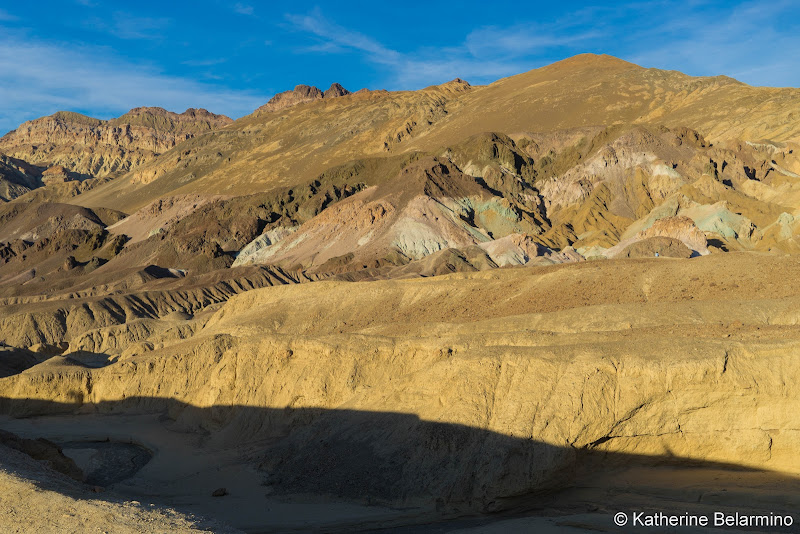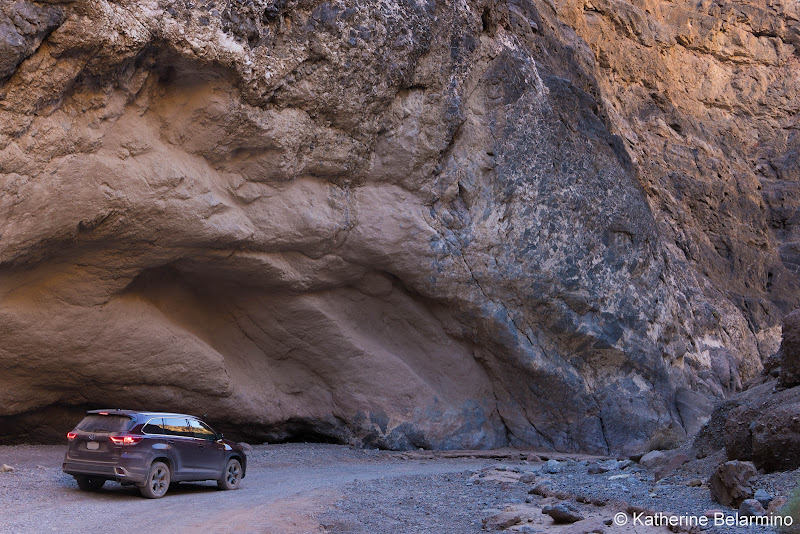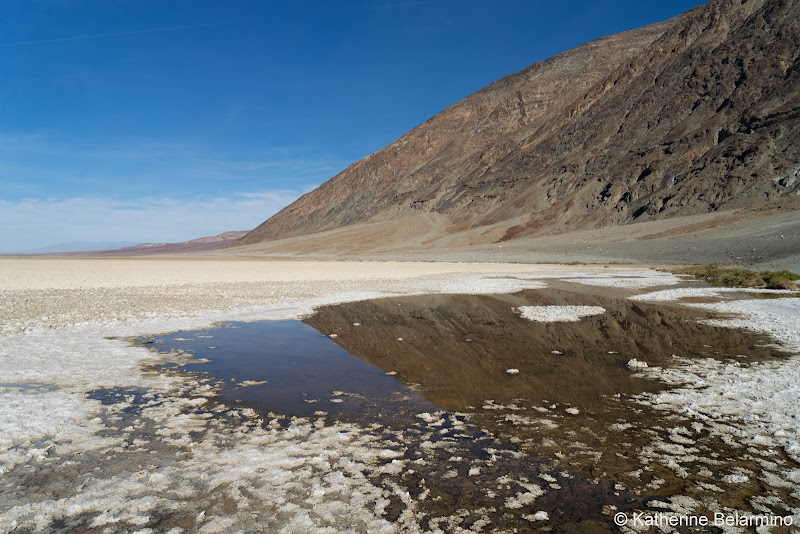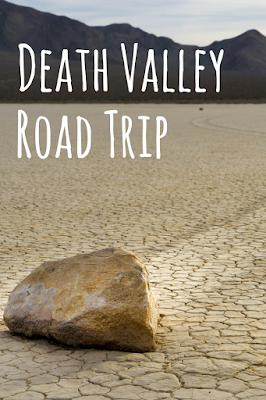Death Valley is the largest U.S. National Park within the contiguous United States. Death Valley is located in eastern California and has valleys, mountains, canyons, salt flats, sand dunes, and oases. Death Valley also has almost 1,000 miles of paved and dirt roads, so is a multi-day road trip within itself. There are so many outdoor adventures to be had in Death Valley. Here are some of the best things to do in Death Valley to put together a full three-day road trip itinerary, including some off-road exploration.
Death Valley Attractions
Badwater Basin
Badwater Basin is the lowest point in North America, at 282 feet below sea level. The Badwater Basin salt flats cover almost 200 square miles. Salt flats occur when there is an enclosed basin that doesn’t drain to the sea, a source of salts, and an arid climate where more evaporation than precipitation occurs. A thin upper crust of salt forms over a mud layer below and salt crystals form along the cracks.
Devils Golf Course
Devils Golf Course isn’t a real golf course (see further down for information about Death Valley’s golf course). It got its name from a line in the 1934 National Park Service guide book which said, “Only the devil could play golf” there. The jagged landscape is created by crystallized salt formations created by ancient salt lakes, wind, and rain. When it’s warm, the expansion and contraction of the salt pinnacles create metallic cracking sounds. The drive out to Devils Golf Course is along a dirt road.
Natural Bridge Canyon
Natural Bridge Canyon was carved by a stream. A fin of rock formed by a sharp bend in the stream eventually had a hole punched into it by pounding floods, creating the 35-foot thick and 35-foot high natural bridge that connects the walls of the canyons. The natural bridge is found about one-third of a mile into the hike, but beyond that there are some other interesting geological formations like dripping mud that looks like wax, hanging canyons, and dry waterfalls. The drive up to National Bridge Canyon is a pretty bumpy dirt road.
Mesquite Flat Sand Dunes
Death Valley National Park has five sand dunes: Mesquite Flat Dunes, Eureka Dunes, Saline Valley Dunes, Panamint Dunes, and Ibex Dunes. Eureka Dunes are the tallest in California, but Mesquite Flat Dunes are the best known and easiest to get to in the park. Mesquite Flat Dunes are even easy to visit at night for astrophotography.
Artist’s Drive
Artist’s Drive is a nine-mile paved road that winds through multi-colored volcanic and sedimentary badlands. This is an especially nice drive for those that can’t take some of Death Valley National Park’s off-roading trails. There are a few stops along the way, including the colorful artist’s palette.
Salt Creek Trail
Salt Creek is a desert oasis situated more than 200 feet below sea level. Salt Creek is the home of the rare Salt Creek Pupfish which thrives in the salty water. A quarter-mile boardwalk follows along the creek to create Salt Creek Trail.
Keane Wonder Mine
Keane Wonder Mine was one of the few profitable mines in Death Valley. The mine was discovered by Jack Keane and Domingo Etcharren in 1904 and it produced over a million dollars in gold from 1904 to 1917. It is one of the best examples of a mine in the national park. A unique feature of the mine is an aerial tramway used to carry gold ore from the mine to the mill. Kean Wonder Mine only recently reopened in November 2017 after having been closed to the public since 2008.
Zabriskie Point
Zabriskie Point is a favorite spot for sunrises and sunsets because of how the badlands capture and reflect the golden and reddish hues.
Ubehebe Crater
Ubehebe Crater is a half-mile across and 500 feet deep. The crater was created by a massive explosion that occurred around 2,000 years ago.
Furnace Creek Golf Course
Furnace Creek Golf Course isn’t one of Death Valley’s natural outdoor attractions, but it is a pretty cool outdoor attraction nonetheless. Furnace Creek Golf Course is the lowest elevation golf course in the world, at 214 feet below sea level. The greens are covered with a fine layer of crusty salt, easily mistaken at first for sand. It’s surprising that grass can grow here at all. The 19th Hole Bar & Grill has a drive-through ramp for golf carts, a fun and unusual feature for a golf course. Because Furnace Creek Golf Course appears in guidebooks as a unique destination because of it being the lowest elevation golf course in the world, people from all over the world come here to play a round of golf . . . even if they’ve never played golf before in their life. We literally overheard a guest ask a golf shop employee if the ball goes on top of the tee. But if you can get out on the course before the novice golfers, it’s a fun round of golf. Beware that at such a low elevation, the golf ball doesn’t go as far. The golf course is pretty flat, but it’s completely surrounded by mountains, and surprisingly there are some water features as well.
Death Valley Off-Road Adventures
Racetrack Playa
One of the most fascinating spots in Death Valley is Racetrack Playa, a dry lakebed dotted with random rocks with trails that stretch behind them. The tracks prove that the rocks move, but how was a mystery until very recently. Scientists discovered through monitoring the rocks that when there is enough rain, the playa becomes a shallow lake. In the winter, the surface freezes into a sheet of floating ice. The ice sheets break in the morning and breezes push the floating ice sheets along with their embedded rocks. When the ice melts and the water evaporates, the rocks are left in their new locations until this happens again, perhaps years later. The trip out to Racetrack Playa is a pretty hairy 27-mile rough dirt road with jagged rocks. A high-clearance vehicle with heavy-duty tires is necessary to make the two-and-a-half hour drive out to the playa.
Titus Canyon
Titus Canyon is the most popular back-country road in Death Valley National Park, and it’s easy to see why. This off-road drive has everything: a ghost town, petroglyphs, mountain views, and a drive through winding canyon narrows. The drive is one way, from east to west, is 27 miles long, and takes a leisurely two to three hours. The last three miles are two-way and can be handled by a standard vehicle. The entrance is on Nevada Highway 374, two miles east of the National Park boundary.
The ghost town of Leadfield was a mining boom town. It was one of the shortest-lived mining towns founded primarily on false advertising. 300 people arrived in 1926, and the town was empty by February 1927.
Klare Spring produces 20 gallons of water a minute which creates a small wetland that bighorn sheep frequent. The Native Americans also spent time here hunting bighorn and creating petroglyphs in the rocks. Sadly, today the rocks contain both ancient and modern petroglyphs.
Twenty Mule Team Canyon
Twenty Mule Team Canyon is a relatively short (less than 3-mile) unpaved road winding through badlands. The name comes from the Twenty Mule Teams which pulled huge wagons carrying borax from Harmony Borax Works to the railroad 165 miles away.
What to Drive Off-Roading in Death Valley
While many of Death Valley’s sites can be seen with any kind of vehicle, Death Valley’s off-road adventures really require a vehicle that’s up to the challenge. Even Devils Golf Course is reached by a dirt road, though that one can be driven by a standard vehicle. But the road to Natural Bridge Canyon and the off-road drives of Titus Canyon, Twenty Mule Team Canyon, and Racetrack Playa should really be driven in a high-clearance off-road capable vehicle. That’s not to say that you won’t see a regular car on those roads, but the likelihood of an issue, like a blown tire, is a risk I wouldn’t want to take.
For our trip to Death Valley, we got a chance to test drive the 2018 Toyota Highlander Hybrid Limited Platinum AWD. I was so thankful to have such a capable vehicle for our off-road drives through Death Valley. Driving off-road on rocky, washboard, pot-holed dirt roads can be nerve-racking, but we had a high sense of security in the Highlander. For off-roading, the features that made us feel safe were the high clearance, the tires that could hold up to sharp rocks, and the all-wheel drive.
We drove from San Diego to Death Valley, and even once there we were driving a lot of miles as Death Valley National Park is so huge, so it was fantastic having the hybrid feature which means we could drive a long time before having to fill up with gas. The interior is also very roomy, with three rows of seats if you have lots of passengers. Or, if going on a road trip with two people, two dogs, and all of the luggage that such a family requires, the last row of seats folds down, providing plenty of room for luggage, camera equipment, a dog pen, a dog buggy, a cooler, and a set of golf clubs.
Not that these features helped with the off-roading, but it didn’t hurt that the 2018 Toyota Highlander Hybrid Limited Platinum AWD also had a pretty luxurious interior with features like super soft leather, a panoramic sunroof, heated and ventilated seats, hands-free entry, and Toyota’s birds-eye view. One feature I particularly enjoyed which was useful for a road trip was the in-dash shelf. It helped me keep my phone, our itinerary, my camera lens cap, charging cord, GoPro, and whatever else I needed easily and quickly accessible.
Death Valley Pass
Visitors to Death Valley must purchase a permit. The vehicle entrance fee ($25 at time of writing) allows all people traveling in a vehicle with a permit to enter and leave the park as many times as they wish during a 7-day period. There are ranger stations and kiosks in a number of places throughout the park.
Death Valley Weather
There’s a reason why Death Valley has the word death in its name. Death Valley gets deathly hot in the summer. Death Valley has the dubious honor of being the hottest place on earth and having the world record for the highest air temperature of 134 degrees Fahrenheit. 120 degrees in the summer isn’t unusual. The best months to visit are November through March, though April and October can be tolerable.






















